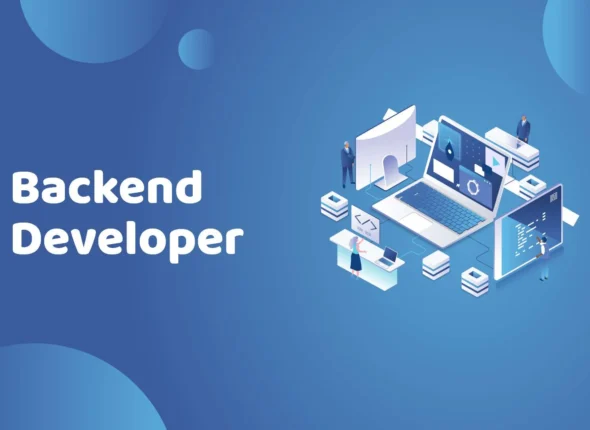Currently Empty: $0.00
About Course
This course is your ultimate guide to mastering the key technologies and tools for web development. With a comprehensive curriculum divided into 6 sections, 267 lessons, and over 27 hours of detailed content, this course will equip you with everything you need.
What will you learn?
-
Web Fundamentals: Understand HTTP, HTTPS, HTTP methods, REST APIs, and W3C standards.
-
HTML and CSS: Learn everything from basic HTML structure to advanced CSS techniques, including Flexbox, Grid, TailwindCSS, and SEO optimizations.
-
Modern JavaScript: Master DOM manipulation, events, operators, functions, ES6+, asynchronous programming (async/await), APIs, and more.
-
React: Build modern interfaces using React, including hooks, Context API, React Router, and Chakra UI.
-
Node.js and SQL: Create robust backends with Node.js and work with relational databases using SQL.
-
Version Control and Agile Methodologies: Learn Git, GitHub, Trello, Jira, and Agile methodologies to manage and collaborate on real-world projects.
-
Practical Projects: Each module includes hands-on exercises and projects to solidify your learning, such as landing pages, calculators, API consumption, and fully integrated systems with databases.
Who is this course for?
-
Beginners looking to start a career in web development.
-
Developers transitioning careers and aiming to expand their skill set.
-
Professionals who want to master the most in-demand technologies.
Benefits:
-
Lifetime access to all course content.
-
Certificate of completion.
-
Direct instructor support for questions.
This course is perfect for anyone seeking a complete journey in web development, starting from scratch and advancing to mastering the most modern technologies. Enroll now and start building amazing projects!
What Will You Learn?
- Build Complete Web Applications: Learn to create projects from scratch, covering both front-end and back-end.
- Master Essential Languages: Work with HTML, CSS, JavaScript, Node js, React, and more.
- Manage Databases Effectively: Build and handle data using MongoDB, MySQL, and other popular tools.
- Implement Authentication and Security: Protect your applications with modern authentication techniques.
- Create Responsive Interfaces: Make your applications accessible on both mobile and desktop devices.
- Dive into RESTful APIs: Develop and integrate APIs following industry best practices.
- Work with Version Control: Use Git and GitHub to collaborate and manage projects efficiently.
Course Content
Introduction
-
What You Will Learn
Basic Module – Introduction to HTML & SEO
-
Introduction to HTTP and HTTPS
-
Basic module – http method
-
What is WWW – The W3C
-
What is an API and REST architecture
-
HTTP response status codes
-
Different ways to program and practice
-
Where to send the exercises
-
Semantic Tags
-
What is HTML
-
How to open HTML
-
HTML Structure – Head Body
-
HTML Title Tags
-
HTML Text Tags
-
Navigation to another HTML
-
HTML Classes
-
HTML ID’s
-
HTML form
-
HTML Input
-
Form input with button submit
-
Audio inside HTML
-
How to embed things inside you
-
Image and Video inside HTML
-
More HTML Tags and Codes
-
Learning basic seo part. 1
-
Learning basic seo part 2
-
Practice – creating a navigation
-
Practice – creating a landing page part 1
-
Practice – creating a landing page part 2
-
Practice – creating a landing page part 3
-
Practice – creating a landing page part 4
-
FIRST MODULE EXERCISE
Intermediate Module – CSS and Styles
-
Introduction to css
-
Css Fonts
-
Css Colors
-
CSS Border Radius
-
CSS outside Font Family
-
CSS border property
-
CSS height property
-
CSS width
-
Display Flex
-
Flex properties
-
Padding and margin
-
Using Grid
-
Reusing css
-
CSS transition
-
CSS Flex
-
CSS Transform
-
CSS Key Frame
-
CSS Hover
-
CSS style types
-
CSS Class Style
-
Tailwind css
-
Getting started with tailwind css
-
Tailwind UI
-
CSS MEDIA QUERY
-
SECOND MODULE EXERCISE
Advanced Module – DOM and Javascript
-
method to locale string
-
How many object can we have
-
Fetch method
-
Async await method
-
Javascript on Click
-
Using on Blur
-
Parameters inside of Functions
-
Function with math operators
-
Getting HTML properties in Javascript
-
Changing properties a button
-
Changing a input properties
-
Applying classes manipulating the DOM
-
Changing DOM Properties with on click Function
-
Adding URL to a property
-
Consuming another API
-
Creating a basic calculator
-
Basic javascript calculator part 2
-
Basic javascript calculator part 3
-
Cleaning Function Code 03:40
-
Javascript more complex objects
-
On Change with HTML
-
The problem with Synchronous programming
-
Async Await
-
Blur event listener
-
Break and Continue statement
-
Calling a functions inside of event listener
-
Chaining callbacks
-
Closures in Javascript
-
Data types and data structure
-
Loops in Javascript – FOR
-
FOR Loop in a practice
-
For in and For of
-
Even hange
-
Javascript Dbl Click event
-
Javascript Operators
-
Introduction to REGEX
-
REGEX to test email
-
Regex atoms and Assertions
-
Promises in Javascript
-
Promise all in Javascript
-
While and Do While
-
Types of event listener
-
Ternary and other operators
-
Strict Mode
-
Scope of Variables
-
Classes in Javascript
-
What is a arrow function
-
Body of arrow functions
-
Arrow functions with line break
-
Javascript Event listener
-
Classes inheritance
-
Classes private properties
-
Ending the content about classes
-
Field declarations
-
Collecting contact informations from client
-
Collecting contact info part 2
-
Collecting contact info part 3
-
Little project with event and Fetch API
-
Improving the zip Code Project
-
Introduction to Node Js
-
Difference between Node Js and Browser
-
NODE JS using app.route
-
NodeJS Express Router
-
NodeJS Introduction to routes
-
NODEJS Route params
-
Nodejs Route Handler and Middleware
-
Creating a Node Js project
-
NODEJS consuming data from express in frontend
-
NVM and Node Versions
-
Javascript
-
What is DOM
-
Diference between HTML, CSS and Javascript
-
Variables at Javascript
-
Const and Variables
-
Importing Javascript
-
Javascript basic system
-
Javascript alert
-
Window prompt
-
What is JSON
-
Template string
-
Camel Case
-
Acessing the DOM in different ways
-
Comparions in Javascript
-
Global Variables and other Ways to do part 1
-
Global Variables and other Ways to do part 2
-
Javascript window prompt
-
Javascript functions
-
Javascript different types of data
-
Filter method Javascript
-
If Else conditions
-
Javascript Map method
-
For Each method
-
Find Index method
-
Extracting infos from a Object
-
Find Index and Index Of
-
Javascript reverse method
-
Javascript unshift method
-
Javascript Pop Method
-
Shift array method
-
Switch statement
-
If statement in mdn
-
If statement inside of a Function
-
Operators
-
Another way to acess object
-
Array Push method
-
Functions with more params
-
THIRD MODULE EXERCISE
Super Advanced Module – Project Version Control
-
Introduction to Git
-
Git and Github version control
-
Initializing a Git repository part 1
-
Initializing a Git repository part 2
-
Initializing a Git repository part 3
-
Initializing a Git repository part 4
-
Initializing a Git Repository part 5
-
What you can do in a github repo part 1
-
What you can do in a github repo part 2
-
Difference between git and github
-
Creating a new branch with Git
-
Git branch structure
-
Git commit without command line
-
Merging a branch
-
Merge using terminal
-
Github challenge
-
Github challenge 2
-
Introduction to react
-
Learning React
-
Quick Start React
-
REACT USE STATE
-
REACT USE STATE part 2
-
HTML and Variables inside of React
-
React Components
-
React components with state
-
React Props
-
React Props (childrens and more)
-
React use State with Inputs
-
React Use Effect
-
React use Effect with Fetch Request part 1
-
React use effect with Fetch Request part 2
-
React Stateless and Statefull components
-
Introduction to React Router Dom
-
React Router Dom
-
React hook Use Ref
-
React showing fetch state in HTML
-
React Context API
-
Principles of Global Context
-
Showing in practice a global state
-
React hot Toast
-
Conclusion and Github challenge
-
SUPER ADVANCED MODULE EXERCISE
Mastery Module – Databases and Servers
-
Introduction to SQL
-
Installing MySQL part 1
-
Installing MySQL part 2
-
Installing MySQL part 3
-
Relational DATABASE
-
SQL and NoSQL databases
-
SQL and NoSQL
-
Comments inside my SQL
-
Create table
-
Drop Table
-
Delete Statement
-
SQL insert into
-
SQL insert into part 2
-
SQL Data Types
-
SQL Select command
-
Showing Select Statement
-
SELECT with Where
-
SELECT WHERE with operators and Clauses
-
UPDATE STATEMENT
-
SELECT with AND OR
-
Select Distinct
-
Limiting the results LIMIT
-
SQL Where Not Statement
-
SELECT with ORDER BY
-
SQL STATEMENT IS NOT NULL IS NULL
-
Understanding JOINS
-
Different types of JOINS
-
Aliases in SQL
-
SQL CASE
-
SQL BACKUP
-
SQL END CONTENT
-
Primary Key
-
Foreign Key
-
FULL JOIN
-
LEFT JOIN
-
RIGHT JOIN
-
Stored Procedures
-
Consuming Data using MySQL
-
NODE JS project with mysql part 1
-
NODE JS project with mysql part 2
-
NODE JS project with mysql part 3
-
NODE JS project with mysql part 4
-
NODE JS project with mysql part 5
-
NODE JS project with mysql part 6
-
NODE JS project with mysql part 7
-
NODE JS project with mysql part 8
-
NODE JS project with mysql part 9
-
NODE JS project with mysql part 10
-
Starting with Typescript
-
Typescript in Visual Studio Code
-
Interfaces as params
-
Interfaces with Typescript
-
Generic Types
-
Structural Type System
-
Chakra UI for React
-
Kanban Tool Trello
-
Agile Tool Jira
-
MASTERY MODULE EXERCISE
-
FIFTH MODULE EXERCISE
Student Ratings & Reviews

No Review Yet



